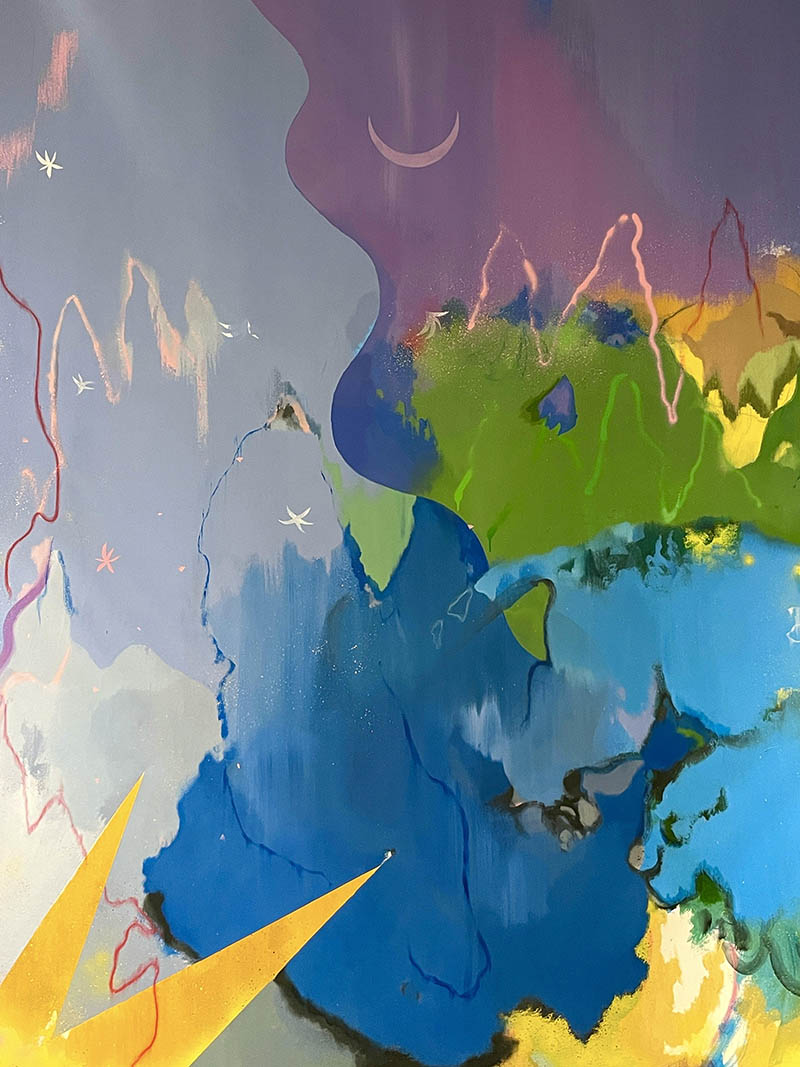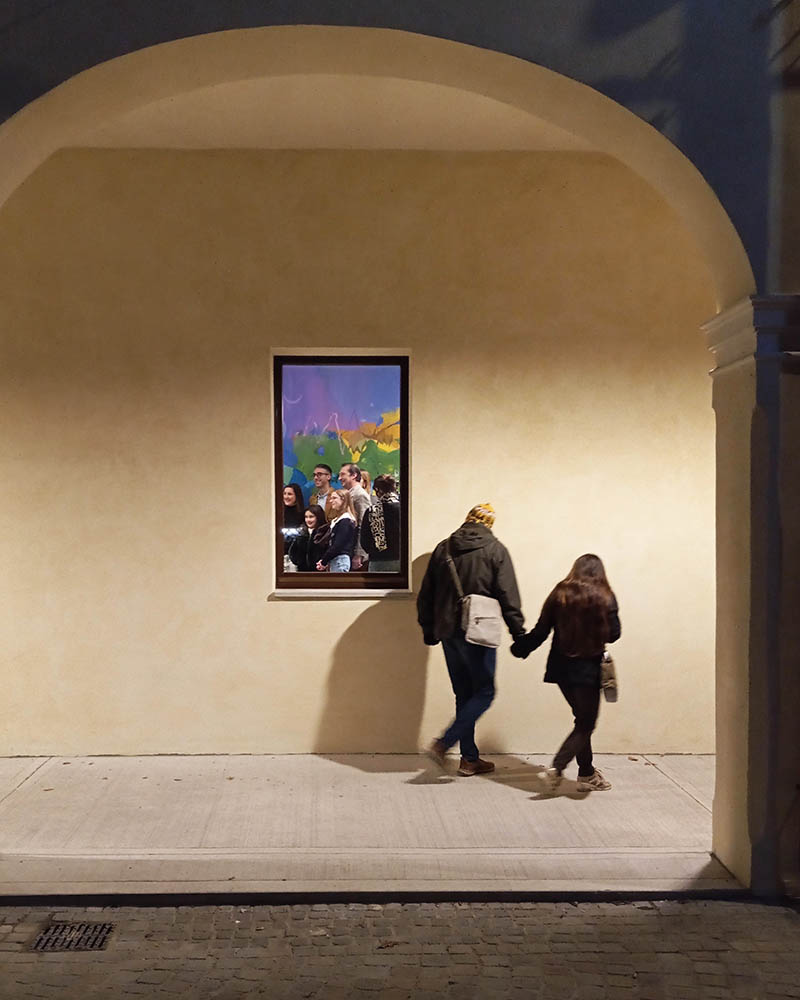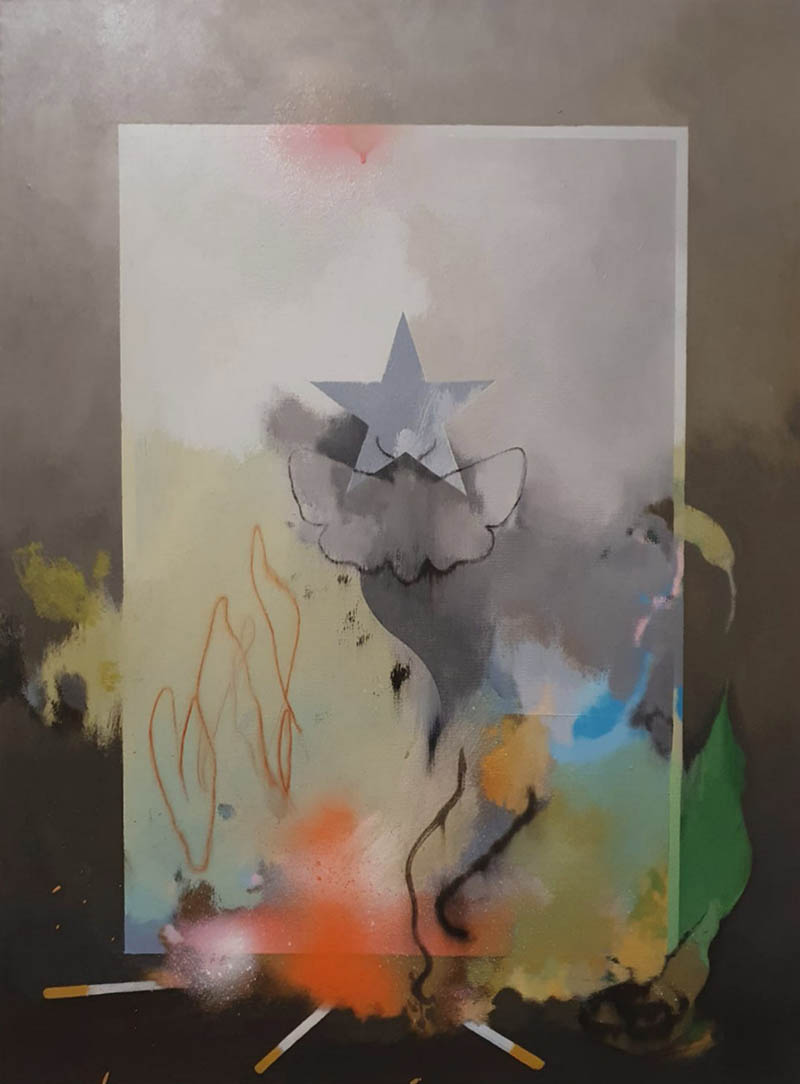
Erka Shalari: Almost two years have passed since the last interview with LNR, which was held in the context of your solo exhibition BLAZE, Giacomo. What has happened in your work during this time?
Giacomo Modolo: Hello friends, thank you for this space. Blaze was a good thing. That cycle broke certain patterns in my painting through a magical gaze. In the past year, I have tried to observe what surrounds me with this attitude, emphasizing the symbolic and imaginary value of the subjects I paint.

The opportunity to create a permanent work at Civica Pinacoteca il Guercino must have been unique. Can you describe how the invitation to undertake this project came about?
I met the Adiacenze team at their gallery in Bologna during a talk organized by La Foresta magazine. A few months later, we had a studio visit in Vicenza, where Amerigo and Giorgia introduced me to the Prospettive project, which promotes contemporary art experiences in the Emilian social context. My research aligned with their initiatives/projects, probably due to the symbolic aspect I was addressing, subsequently receiving approval from Cento’s cultural department.

It would be exciting to hear about the process of the mural’s emergence. How has it been to work with the archives – delve into the oeuvre of Guercino and, at the same time, work on your piece?
Everything has been very intense, dense, and at the same time fast. Seven days to physically engage with the previously inaccessible archive and create the painting. Upon arriving at the pinacoteca, the impact was powerful, also thanks to the careful arrangement of the rooms and the passion conveyed by the director.
Beyond the pictorial greatness and the intriguing Baroque complexity, Guercino’s work resonated with me for the „atmosphere“. I’m talking about the sky, evanescent environments, naturalistic and decorative elements seemingly secondary to the central themes of the canvases.
This approach allowed me to start a more serene dialogue with the painter and create a language inspired by the room that hosted me, specifically the didactic room, where young people gather nowadays.
I wonder what you have felt as challenging in realising this project. In the end, we deal with the creation of a permanent work (…)
The tight deadlines had an impact especially on my artistic approach, putting me in a position to develop an energetic painting. Furthermore, the evolution of the work has always been monitored by the Pinacoteca’s staff, a truly new condition for me. I sensed the surrounding electricity of a heterogeneous and fascinating working team, composed of restorers, workers, and architects who often stopped to exchange words about what I was doing.

Artist. Giacomo Modolo 
Artist. Giacomo Modolo
Their opinions about the interpretation of the forms they saw growing undoubtedly contributed to the evolution of my work. Perhaps this is also the essence of experiencing the „residency“ of a „place“.
Unpacking the complexity of the mural, what themes or elements are embedded in its intricate layers?
Maintaining a relationship with one’s ongoing research, trying not to slip into circumstantial languages. I worked with different graphic/pictorial mediums, exploiting the hardness of the supporting wall. This allowed me to discover new qualities, playing with overlays, and glazes, and using even an “aggressive” approach. I also enjoyed using oil pastels and doing certain things experimenting with sprays. I decided to exclude a wall frame from the painting, evoking the idea of a hanging picture.

How important are rituals to you? I read the word „purifing rituals“ quite a few times.
The Ritual is a pictorial cycle started a year ago for Crag Gallery. It involves a series of images where a small fire takes place, a kind of bonfire with an inverted pyramid structure. At the top, I paint skulls, flowers, or objects close to the idea of a still life that burns and dematerializes, creating an opportunity to connect with new forms.
For me, painting is a ritual that destroys and recreates itself through its own material, landing in unusual territories that sometimes should be accepted at the expense of one’s certainties.
Regarding my project for Cento, this bonfire changes its dimension along the entire perimeter of the wall, becoming the environment. The subjects always stand a step back from their clear definition, allowing free interpretation.

What lies around you right now in the Studio? Works that are to be finished, ideas and so on. What do you wish for the upcoming year?
New visual stimuli for a personal project that I would like to develop by next summer. I am trying to give continuity to the magical element in relation to images drawn from personal and collective daily life. Moreover, I am closer to a political approach in this period, which already started with my works for the recently concluded Autocensura exhibition in Turin.


Giacomo Modolo, Young writer, 2023,a crylic on cotton grezzo, 40 x 30 cm
*The work „The Ritual“ can be seen at Civica Pinacoteca il Guercino
Opening Hours: Wednesday – Sunday, from 10.00 – 18.00 o’clock
Vernissage: 3.12.2023
www.civicapinacotecailguercino.it
Giacomo Modolo (1988) is an Italian painter who lives and works in Vicenza. After graduating at the Art School, obtained his bachelor degree in Graphic Arts at the Academy of Fine Arts in Venice on February 2011 and, at the same institution, a postgraduate degree in Decoration on February 2013. He took part in several group exhibitions in Italy and abroad, displaying paintings, drawings and graphics. Currently his work is represented by Crag Gallery in Turin. Characterized by an apparent falsification and deconstruction of representation, the works of Giacomo Modolo actually depict subjects and objects which have a vivid spatial and figurative concreteness. The artist expresses himself in a synthesis of shapes and colors that gives life to human figures contextualized in environments without visible references, a result of the imagination and insight of the artist. This leads to a materialization of thought that manifests itself first with the design, through what he calls the “sign”. Following the painting, that gives shape and volume in a perfect balance, capable of representing the internal dynamism of the composition. The subjects are moving within the painting, in a conscious elaboration and representation of stories, experiences and memories that have been narrated and subsequently reinterpreted in the contemporary world, www.instagram.com/jack_modolo/.
About ADIACENZE. Founded in the cultural heart of Bologna in 2010, adiacenze embodies the spirit of liberated, multidisciplinary projects that defy the constraints of the market. With a dedicated commitment to championing emerging artists and their diverse creative expressions, the organization places a unique emphasis on spatial considerations and the realization of site-specific works. They promote, curate, research, and collaborate. ADIACENZE’s overarching mission is to cultivate an environment that nurtures the dissemination and profound understanding of emerging artists, all while contemplating the future and recognizing the central role of emerging art in the rich tapestry of the Italian cultural landscape. Functioning as a dynamic and hybrid hub, ADIACENZE breathes life into a myriad of activities, ranging from thought-provoking exhibitions to diverse workshops encompassing realms as varied as songwriting and ceramics. The organization also delves into the realm of independent art magazine publishing and orchestrates both temporary and permanent site-specific art. In essence, the space is a celebration of contemporary art in Italy – www.adiacenze.it





